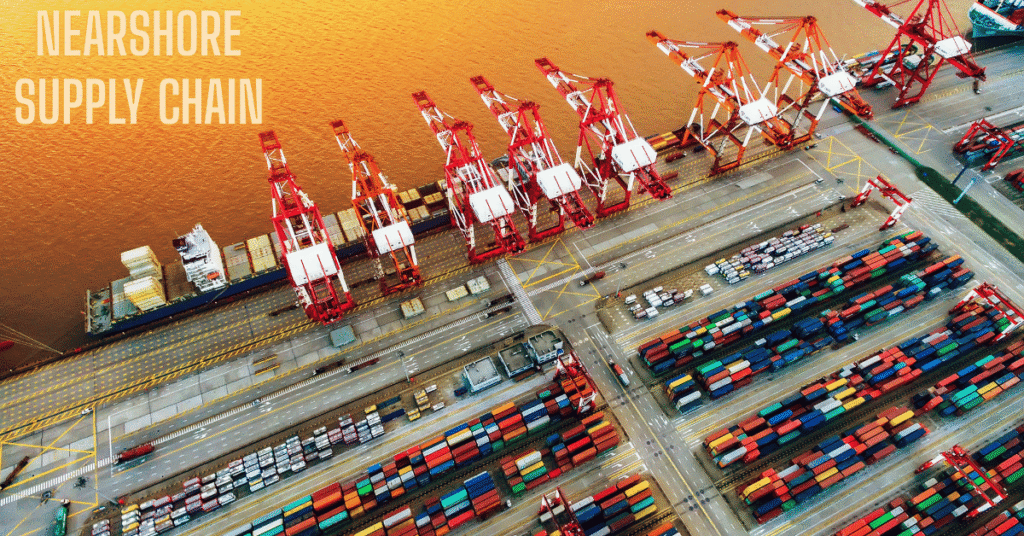Introduction
Supply chain strategy must be remodelled from time to time to suit changing market demand, risk management, and to improve efficiency. This is even more pronounced in today’s increasingly intertwined world. Nearshoring supply chain models have become the fastest rising supply chain model in importance in today’s world. Nearshoring minimizes the distance from the OTC load, relative to responsiveness on variables like cost or lead time, compared to the original offshore model that these companies use.
Here, an analysis of nearshore supply chains is conducted along with their pros and cons; reasons that lead many to think that surely, this is the most viable long-term remedy for making these business models more resilient and sustainable. The discussion of basic premises surrounding the nearshore supply chain will give insight into its contemporary relevance in logistics and supply chain-related matters.
What is Nearshore Supply Chain?
In terms of end-to-end supply chain operations, the nearshore supply chain is in proximity to the final consumers, either in manufacturing, assembly, or other supply chain functions proximity to the adjacent neighboring area or region within an offshore outsourcing. Offshore outsourcing typically means outsourcing companies to other countries far apart usually considered low cost by those countries around the globe.
In other words, a perfect example can be the new wave of companies outside the U.S. that are re-deploying their production operations from China to Mexico. This case is where the operations will move from offshore to a nearshore supply chain.
Reasons for Moving Towards a Nearshore Supply Chain Model Within Enterprises
The trend is primarily determined by the following motives, which encourage this class of companies to shift toward nearshore locations:
Supply Chain Disruptions
These lengthy and complicated supply chains were made in sharp contrast according t that made this worse. Major bottlenecks were created due to shipping delays, abrupt closures of factories, and congestions within ports. The said nearshoring supply chain presented a very simple model for effecting cost that tap through difficulty.
Increasing Transportation Costs
Moving toward near-shore and on developing markets will increase the cost of transporting goods substantially above what has been previously called a reasonable distance; that is, the distance those goods have to travel.
Geopolitical Risks
They fairly quickly become serious tariffs, lengthening wars of trade between nations, and any other international quarrels tend to create a long-lasting uncertainty for rather cumbersome global supply chain operations. Creating facilities in politically stable neighboring countries would do much to mitigate the effects of these geopolitical uncertainty risks for enterprises following a nearshore supply chain model.
Environmental Considerations
The increasing concern for global warming has to do with carbon emissions, which are making consumers and regulators responsible for that. A near-shore supply chain reduces travel distances ultimately, leading to emissions reductions.
Market Acceleration
Production within the near-market enables speedy access to markets. These flexibilities become vital in industries where demand changes quickly, such as in fashion, electronics, and automotive.
Advantages of Nearshore Supply Chain
There are quite many fascinating advantages of the nearshore supply chain:
1. Shorter Lead Time
Short lead time is the most attractive benefit of nearshore supply chains. Providing stocks quickly for replenishing products means quicker intervention against the client’s necessity and less carrying costs.
2. Better Collaboration and Communication
Collaboration between teams, vendors, and partners is greatly improved compared to when working in almost the same time zone. This very immediate proximity will further enhance the quick addressing of issues through instant coordination.
3. Quality Checks
Companies find it far easier for quality control to keep in place better relationships with those suppliers by inspection of their operations in nearby countries.
4. Cost Savings
When tracking back nearshore environments as contrasted to offshore, the nearshore model has much costlier labor than what is offshore. Thus, savings that subsidize logistics, transportation, and risk management typically minimize all of that.
5. Resilience in Supply Chain
Nearshoring increases resilience in two different ways: once because it reduces the dependence of supply chains on fragile international networks that can be cut off at any time and, second, by providing flexibility for very same chains.
Common Industries Favorable Nearshore Supply Chain
Always nearshore industries include: Fashion and Footwear: Industries nearshore for quick responses to trends and demand. Automotive: It works wonders with very short lead times and just-in-time manufacture. Electronics: Demand a fast flow of agile manufacturing and delivery. Consumer Goods: The company must remain sensitive and flexible in responding to local market requirements. Medical Supplies: Proximity is as important as speed and regulation.
Most Favorite Nearshore Destinations
From North America, Latin America, and the Caribbean have always favored a nearshore destination-Mexico, Costa Rica, and Colombia being the front runners. Eastern European countries and North African countries like Morocco and Tunisia had European countries to which their companies have been favoring. In terms of cheap labor and market proximities coupled with rapid improvement of infrastructures, these sites become ideal.
Nearshore supply chains have their apparent benefits, but are also burdened with a few disadvantages:
1. Higher Labor Cost
Labor at a nearshore place could sometimes become uncompetitive with offshore labor, and hence, the costs of labor should be compared with those of transport costs and risk mitigation.
2. Infrastructure Gap
Then, some nearshores may be pretty much undeveloped and in the process of growing, but will never achieve the infrastructure level of developed offshore or selected offshore.
3. Regulatory Differences
Even if near countries, businesses face the burden of differences in legal, regulatory, and tax environments.
Strategic Issues on Nearshoring Supply Chains
Companies would have to plan and analyze the facts significantly if there were more changes in the supply chain being moved to the nearshore:
- Cost Benefit Analysis: Include, in all cases, the costs incurred for land, labor, transport, taxes, and tariffs.
- Risk Assessment: Define also economic, political, and operational risks when targeting a country.
- Supplier Assessment: Identify and assess possible suppliers for capability or credential validation.
- Logistics Planning: relative evaluation for transportation networks, customs processes, and warehousing requirements.
- Technology Integration: Confirm that the digital supply chains will come along with the new partners and workflows.
Strengthening Nearshore Supply Chain with Technology
Technology opens the door to consequences that have been promised by nearshore supply chains, such as:
- Supply Chain Management Software: Provides tracking in real-time, forecasting, and optimization.
- Automation and Robotics: the least amount of dependence on human labor capability, but maximizing the productivity of industries.
- Data Analytics: Powerful Discernments for identification and prediction concerning disruptions to plants.
- Blockchain: Forms of Transparency, Traceability, and Trust In-Between Partners within the Supply Chain.
- IoT Devices: Improving visibility of the state of transit of goods, as well as conditioning.
Nearshore Supply Chain in the Future
This is the case with many new things that are being established for a nearshore supply chain strategy: It is growing fast in the rapidly transforming new paradigms of global supply chain strategy. The more a strategy settles down in nearshoring, the more it will become stamped with resilience, sustainability, and satisfaction of customers to be folded into this way of thinking.
And at the same time, other areas are made attractive by the incentives provided by governments, trade agreements, and investments in infrastructure, such as USMCA, which will electrify trading in the region and flow much more towards Nearshoring on developments of North America.
Summary
Using nearshore supply chains strategically positions firms to be part of living and operating in a very dynamic and often turbulent world market. These reduced risks, speed, and quality controls, and enhancement of responsiveness to consumer needs all come from close-up production and supply operations to these foreign ports.
Nearshoring operations will need investment and huge plans; however, once properly done, the results—thunderous speed to market, cost containment, collaboration, and sustainability—will indeed be thousands-fold more than that.
Nearshore supply chains will always be in the limelight of supply chain management as continuous technological advancements keep showering and thus maturing the landscape of international trade.
FAQs
Q1: What’s the difference between nearshoring and offshoring?
A: Nearshoring refers to moving closer to the supplying country to perform its operations for the supply chain, while offshoring refers to transporting inputs significantly far away to another continent where low-cost countries can cover the operations.
Q2: What are the main benefits of a nearshore supply chain?
A: Lead time is very fast; transportation costs are lighter, quality has improved, collaboration has increased, and supply chains are resilient, some of the many benefits.
Q3: What challenge is faced in creating a nearshore supply chain?
A: Challenges in establishing nearshore supply chains include such things as a lack of labor-sometimes even more costly than offshore-infection of isolated capacity or capability in areas, possible infrastructural problems, and regulatory issues.
Q4: How do nearshoring practices affect the environment?
A: Most likely, really nearshoring will be associated with a marked decrease in carbon emissions because of shorter distances travelled and hence a much more sustainable approach that is also friendly towards the environment.
Q5: Between nearshoring and offshoring: Is one less costly than the other?
A: Not, as quite near the shore country might have high labor costs, but savings from logistics and inventory management and risk mitigation usually offset or outweigh the higher costs.
Q6: Nearshoring places: give me examples.
A: American companies most frequently prefer Mexico and Costa Rica as nearshoring destinations, whereas Polish companies favor Romania and Morocco.



